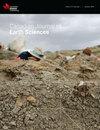Rapid coastal erosion of ice-bonded deposits on Pelly Island, southeastern Beaufort Sea, Inuvialuit Settlement Region, western Canadian Arctic
IF 1.6
4区 地球科学
Q3 GEOSCIENCES, MULTIDISCIPLINARY
引用次数: 2
Abstract
This paper quantifies rates of shoreline change and investigates the influence of surficial geology on shoreline dynamics between 1950 and 2018 on Pelly Island, located 10 km off the Mackenzie Delta. Long-term changes in shoreline position were calculated using imagery analysis and Analysing Moving Boundaries Using R (AMBUR). The influence of shoreline exposure to predominant storm direction and influence of surficial geology were examined for Northwest and Southeast zones. The average annual linear regression rate (LRR) rate during the 1950-2018 observation period was -3.8 m∙a-1. The end point rate (EPR) was calculated for six observation periods: 1950-1972, 1972-1985, 1985-2000, 2000-2018, 2013-2018. A mean EPR of -5.5 ± 0.7 m∙a-1 was calculated for the 2000-2018 period, and a maximum retreat rate of 46.7 ± 2.1 m∙a-1 was recorded during the 2013-2018 observation period. By comparing the rate of change for sections of historical shorelines with differing surficial geology and exposure to storms, it was possible to draw conclusions on why Pelly Island continues to have the highest retreat rates in the Mackenzie-Beaufort region. Greater retreat rates were observed in lacustrine deposits (5.3 m∙a-1) compared to moraine deposits (2.7 m∙a-1). In addition, shoreline exposure to the predominant storm direction from the Northwest was found to be a major influence on rates of shoreline change in all observation periods.加拿大西部北极地区因纽瓦卢特人定居区,波弗特海东南部Pelly岛冰结合沉积物的快速海岸侵蚀
本文量化了海岸线变化的速度,并调查了1950年至2018年间,位于麦肯齐三角洲10公里外的Pelly岛的地表地质对海岸线动态的影响。利用影像分析和基于R (AMBUR)的移动边界分析计算岸线位置的长期变化。研究了西北、东南带岸线暴露对主要风暴方向的影响和地表地质的影响。1950—2018年观测期内的年平均线性回归率(LRR)为-3.8 m∙a-1。计算了1950 ~ 1972年、1972 ~ 1985年、1985 ~ 2000年、2000 ~ 2018年、2013 ~ 2018年6个观测期的终点率(EPR)。2000-2018年平均EPR为-5.5±0.7 m∙A -1, 2013-2018年最大退缩率为46.7±2.1 m∙A -1。通过比较不同地表地质和暴露于风暴的历史海岸线部分的变化率,可以得出结论,为什么Pelly岛在麦肯齐-博福特地区继续具有最高的退缩率。与冰碛沉积物(2.7 m∙a-1)相比,湖泊沉积物(5.3 m∙a-1)的退缩率更高。此外,在所有观测期间,海岸线暴露于西北主要风暴方向是海岸线变化速率的主要影响因素。
本文章由计算机程序翻译,如有差异,请以英文原文为准。
求助全文
约1分钟内获得全文
求助全文
来源期刊

Canadian Journal of Earth Sciences
地学-地球科学综合
CiteScore
2.80
自引率
7.10%
发文量
66
审稿时长
6-12 weeks
期刊介绍:
The Canadian Journal of Earth Sciences reports current research in climate and environmental geoscience; geoarchaeology and forensic geoscience; geochronology and geochemistry; geophysics; GIS and geomatics; hydrology; mineralogy and petrology; mining and engineering geology; ore deposits and economic geology; paleontology, petroleum geology and basin analysis; physical geography and Quaternary geoscience; planetary geoscience; sedimentology and stratigraphy; soil sciences; and structural geology and tectonics. It also publishes special issues that focus on information and studies about a particular segment of earth sciences.
 求助内容:
求助内容: 应助结果提醒方式:
应助结果提醒方式:


